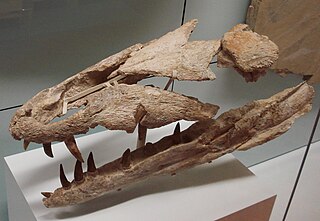
Dakosaurus is an extinct genus of crocodylomorph within the family Metriorhynchidae that lived during the Late Jurassic and Early Cretaceous. It was large, with teeth that were serrated and compressed lateromedially. The genus was established by Friedrich August von Quenstedt in 1856 for an isolated tooth named Geosaurus maximus by Theodor Plieninger in 1846. Dakosaurus was a carnivore that spent much, if not all, its life out at sea. The extent of its adaptation to a marine lifestyle means that it is most likely that it mated at sea, but since no eggs or nests have been discovered that have been referred to Dakosaurus, whether it gave birth to live young at sea like dolphins and ichthyosaurs or came ashore like turtles is not known yet. The name Dakosaurus means "biter lizard", and is derived from the Greek dakos ("biter") and σαῦρος -sauros ("lizard").
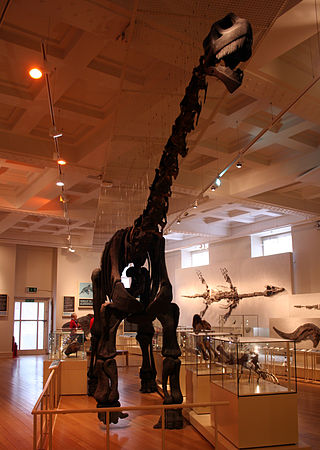
Cetiosaurus meaning 'whale lizard', from the Greek keteios/κήτειος meaning 'sea monster' and sauros/σαυρος meaning 'lizard', is a genus of herbivorous sauropod dinosaur from the Middle Jurassic Period, living about 168 million years ago in what is now Britain and probably France.
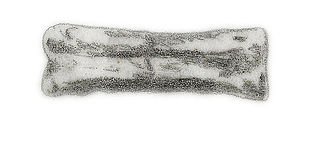
Teinurosaurus is a genus of carnivorous theropod dinosaur. Teinurosaurus lived during the Late Jurassic in what is now France. The type species is Teinurosaurus sauvagei. It has been estimated to be 11.4 m (37.4 ft) in length and 3.6 tonnes in weight.

Morinosaurus was a genus of sauropod dinosaur from an unnamed formation of Kimmeridgian-age Upper Jurassic rocks from Boulogne-sur-Mer, Département du Pas-de-Calais, France. It is an obscure tooth genus sometimes referred to the Lower Cretaceous English wastebasket taxon Pelorosaurus.
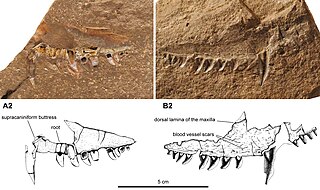
Neosaurus is an extinct genus of pelycosaur-grade synapsids from the Late Carboniferous-Early Permian of the Jura region of France. It is known only from a partial maxilla or upper jaw bone and an associated impression of the bone. The teardrop shape of the teeth in the jaw indicate that Neosaurus belongs to the family Sphenacodontidae, which includes the better-known Dimetrodon from the Southwestern United States. The maxilla was first attributed to an early diapsid reptile in 1857, and later a crocodylomorph in 1869, before finally being identified as a sphenacodont synapsid in 1899, a classification that still holds today.

Neosodon was a genus of sauropod dinosaur from the Late Tithonian-age Upper Jurassic Sables et Gres a Trigonia gibbosa of Pas-de-Calais department, France. It has never been formally given a species name, but is often seen as N. praecursor, which actually comes from a different animal. Often in the past, it had been assigned to the wastebasket taxon Pelorosaurus, but restudy has suggested that it could be related to Turiasaurus, a roughly contemporaneous giant Spanish sauropod. It is only known from six teeth.
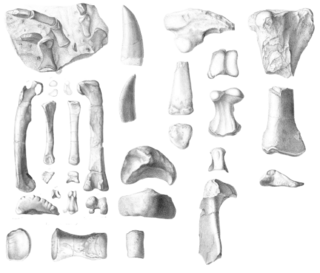
Erectopus is an extinct genus of basal allosauroid theropod from the Early Cretaceous La Penthiève Beds Formation of France and also possibly the Cernavodă Formation of southern Romania. The type species is E. superbus, which was initially known as a species of Megalosaurus.

Machimosaurus is an extinct genus of machimosaurid crocodyliform from the Late Jurassic and Early Cretaceous. The type species, Machimosaurus hugii, was found in Switzerland. Other fossils have been found in England, France, Germany, Portugal, Switzerland and Tunisia. Machimosaurus rex is the largest named teleosauroid and thalattosuchian, with an estimated length of up to 7.15 m (23.5 ft). Machimosaurus is the largest known crocodyliform of the Jurassic.

Steneosaurus is a dubious genus of teleosaurid crocodyliform from the Middle or Late Jurassic of France. The genus has been used as a wastebasket taxon for thalattosuchian fossils for over two centuries, and almost all known historical species of teleosauroid have been included within it at one point. The genus has remained a wastebasket, with numerous species still included under the label ‘Steneosaurus’, many of which are unrelated to each other.
The Caranguejeira Conglomerate is an Aptian to Cenomanian geologic formation in Portugal. Dinosaur remains diagnostic to the genus level are among the fossils that have been recovered from the formation.

Joseph Henri Ferdinand Douvillé, also known as Henri Douvillé, was French paleontologist, geologist and malacologist. Douvillé worked as a mining engineer in Bourges (1872) and Limoges (1874), afterwards serving as professeur suppléant of paleontology at the École des Mines. From 1881 to 1911 he was a professor of paleontology at the École des Mines.

Philippe-Charles or Philip Carel Schmerling was a Dutch/Belgian prehistorian, pioneer in paleontology, and geologist. He is often considered the founder of paleontology.
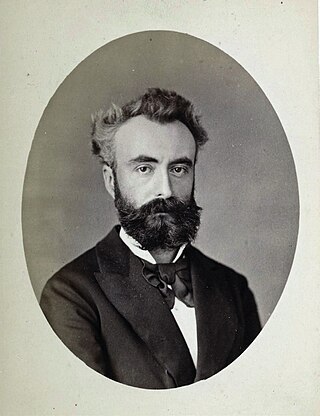
Henri Émile Sauvage was a French paleontologist, ichthyologist, and herpetologist. He was a leading expert on Mesozoic fish and reptiles.
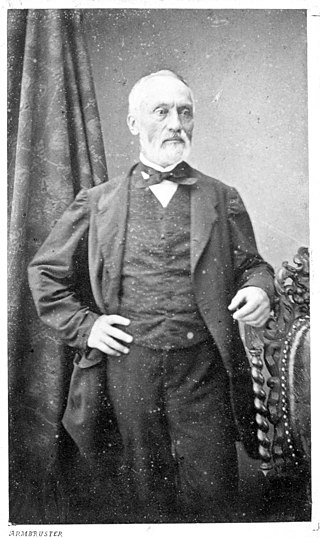
Eugène Dumortier was a French paleontologist.

Louis Édouard Gourdan de Fromentel was a French physician and paleontologist known for his study of fossil coral polyps and sponges.
Victor-Auguste Gauthier was a French school teacher and amateur palaeontologist. He specialized in the study of fossilized sea urchins, contributing meticulous descriptions of many fossils found in southern France, Algeria, Tunisia and Persia.

Alphonse Péron was a French soldier and amateur naturalist. He used his spare time to pursue his interest in paleontology, and authored or coauthored several important works on the geology and paleontology of France and Algeria.

The El Mers Group is a geological group in the Middle Atlas of Morocco. It is subdivided into three formations named the El Mers I, II, and III Formations, respectively. It is a marine deposit primarily consisting of marl, with gypsum present in the upper part of unit 3. It is the lateral equivalent of the terrestrial Guettioua Sandstone. Dinosaur remains are among the fossils that have been recovered from the group, most notably those of sauropods and the unusual thyreophorans Adratiklit, Thyreosaurus, and Spicomellus. This formation records a series of coastal to shallow marine settings of Middle Jurassic, based on detailed stratigraphical biomarkers such as ammonites or Foranimifera.

Proexochokefalos is an extinct genus of machimosaurid teleosauroid from the Jurassic of France
Gilles Joseph Gustave Dewalque was a Belgian physician, geologist, paleontologist, and mineralogist.
















